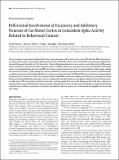| dc.contributor.author | Putrino, David F. | |
| dc.contributor.author | Brown, Emery N. | |
| dc.contributor.author | Mastaglia, Frank L. | |
| dc.contributor.author | Ghosh, Soumya | |
| dc.date.accessioned | 2012-04-13T14:25:58Z | |
| dc.date.available | 2012-04-13T14:25:58Z | |
| dc.date.issued | 2010-06 | |
| dc.identifier.issn | 0270-6474 | |
| dc.identifier.issn | 1529-2401 | |
| dc.identifier.uri | http://hdl.handle.net/1721.1/70010 | |
| dc.description.abstract | To assess temporal associations in spike activity between pairs of neurons in the primary motor cortex (MI) related to different behaviors, we compared the incidence of coincident spiking activity of task-related (TR) and non-task-related (NTR) neurons during a skilled motor task and sitting quietly in adult cats (Felis domestica). Chronically implanted microwires were used to record spike activity of MI neurons in four animals (two male and two female) trained to perform a skilled reaching task or sit quietly. Neurons were identified as TR if spike activity was modulated during the task (and NTR if not). Based on spike characteristics, they were also classified as either regular-spiking (RS, putatively excitatory) or fast-spiking (FS, putatively inhibitory) neurons. Temporal associations in the activities of simultaneously recorded neurons were evaluated using shuffle-corrected cross-correlograms. Pairs of NTR and TR neurons showed associations in their firing patterns over wide areas of MI (representing forelimb and hindlimb movements) during quiet sitting, more commonly involving RS neurons. During skilled task performance, however, significantly coincident firing was seen almost exclusively between TR neurons in a smaller part of MI (representing forelimb movements), involving mainly FS neurons. The findings of this study show evidence for widespread interactions in MI when the animal sits quietly, which changes to a more specific and restricted pattern of interactions during task performance. Different populations of excitatory and inhibitory neurons appear to be synchronized during skilled movement and quiet sitting. | en_US |
| dc.description.sponsorship | National Institutes of Health (U.S.) (Grant DP1-OD003646) | en_US |
| dc.description.sponsorship | National Institutes of Health (U.S.) (Grant R01-DA015644) | en_US |
| dc.description.sponsorship | Australian Neuromuscular Research Institute | en_US |
| dc.language.iso | en_US | |
| dc.publisher | Society for Neuroscience | en_US |
| dc.relation.isversionof | http://dx.doi.org/10.1523/jneurosci.0770-10.2010 | en_US |
| dc.rights | Article is made available in accordance with the publisher's policy and may be subject to US copyright law. Please refer to the publisher's site for terms of use. | en_US |
| dc.source | SFN | en_US |
| dc.title | Differential Involvement of Excitatory and Inhibitory Neurons of Cat Motor Cortex in Coincident Spike Activity Related to Behavioral Context | en_US |
| dc.type | Article | en_US |
| dc.identifier.citation | Putrino, D. et al. “Differential Involvement of Excitatory and Inhibitory Neurons of Cat Motor Cortex in Coincident Spike Activity Related to Behavioral Context.” Journal of Neuroscience 30.23 (2010): 8048–8056. Web. | en_US |
| dc.contributor.department | Harvard University--MIT Division of Health Sciences and Technology | en_US |
| dc.contributor.department | Massachusetts Institute of Technology. Department of Brain and Cognitive Sciences | en_US |
| dc.contributor.approver | Brown, Emery N. | |
| dc.contributor.mitauthor | Putrino, David F. | |
| dc.contributor.mitauthor | Brown, Emery N. | |
| dc.relation.journal | Journal of Neuroscience | en_US |
| dc.eprint.version | Final published version | en_US |
| dc.type.uri | http://purl.org/eprint/type/JournalArticle | en_US |
| eprint.status | http://purl.org/eprint/status/PeerReviewed | en_US |
| dspace.orderedauthors | Putrino, D.; Brown, E. N.; Mastaglia, F. L.; Ghosh, S. | en |
| dc.identifier.orcid | https://orcid.org/0000-0003-2668-7819 | |
| mit.license | PUBLISHER_POLICY | en_US |
| mit.metadata.status | Complete | |
